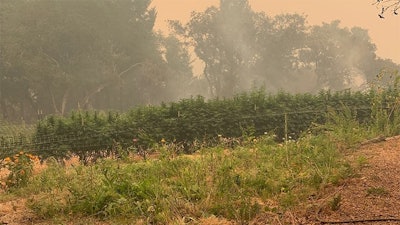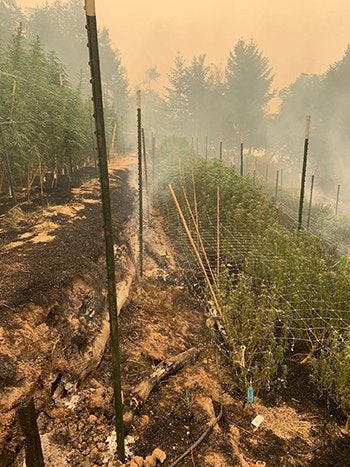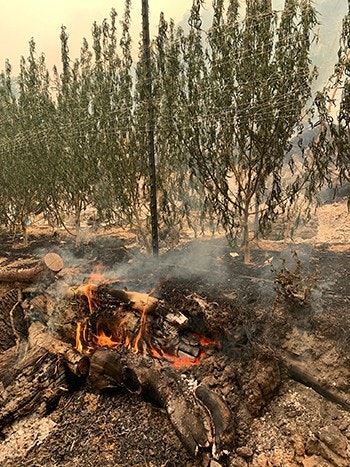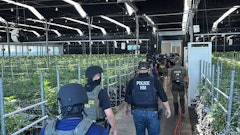
Since mid-August, wildfires have burned through more than 1 million acres of California land. It’s another echo of a recurring environmental catastrophe in a state that more than 5,000 licensed cannabis growers call home.
 california wildfire cannabis
california wildfire cannabisFor Keala Peterson, whose family runs a farmstead in the hills above Santa Rosa, the Lnu Lightning Complex fires have brought swift devastation to her property, Sweet Creek Farm. When we spoke with her on Aug. 25, she said that some 95% of the property had been torched by the fast-moving fires.
At Sweet Creek, Peterson’s family had been growing Hawaiian sativa cultivars and other hybrids (among their many vegetable crops, as well). The cannabis buds hadn’t set when we spoke with Peterson, and she was hopeful that perhaps the smoke and ash of the blaze hadn’t settled on the flowers themselves. “We’re not holding our breath, but that’s a little bit of a silver lining,” she said.
On Aug. 19, Peterson was in Santa Rosa, where she lives with her husband, paying close attention to what was happening up on the ridgelines.
“I was watching the camera that faces kind of directly over the property, and I saw this glowing fire wall,” she said. “It was unbelievable.” She spoke with her mother, who was already packing the bags, and decided to head up the mountain to meet her family.
The property was pretty well safeguarded against certain kinds of fire. Peterson’s father is a retired firefighter and a vocal proponent of good fire safety practices. By nightfall, the scope of the wildfire in the hills was clear.
“We could clearly see the fire coming over the ridgeline and torching 30-ft. pine trees in a flash,” she said. “You could hear the sound of the fire. It creates its own kind of weather, and it sounded like a freight train roaring.”
It seemed like it was going to crash across the farm any second.
Peterson and her family are safe. But she said that they know all too well how pervasive this threat has become in California.
“Historically,” she said, “cannabis culture has always been up in the hills, and now, with a multitude of factors, the wildfires are really putting the whole culture in jeopardy.”
This is a long-term crisis—not only for cannabis growers, of course, but for people and businesses alike. For those cultivating cannabis in wildfire-prone hills of California, however, the concern is acute.
Peterson offered three tips for growers hoping to guard against the oppressive force of wildfire.
Create a defensible space.
This is something that Peterson’s father has constantly discussed on the farmstead. Create firebreaks around your property: gaps in vegetation that force the fire to slow down and settle before advancing into more fields of fuel. “Creating that defensible space is super important,” Peterson said.
In 2017, Sweet Creek was caught in the path of the Tubbs Fire, a very destructive wide-driven wildfire. There’s little to be done about a wildfire moving that fast, Peterson said. But the Lnu Lighting Complex fires
“In this one, it’s a classic kind of wild land fire, where it just creeps and spot fires happen,” she said. “If you create that defensible space around your garden or your home, then it's more likely that the first responders will be able to actually save your home.”
 california wildfire sweet creek farm
california wildfire sweet creek farmRake back your hay.
At Sweet Creek, some of the farmstead’s hay caught fire, which is what led to the burning across the cannabis plants.
“In the future, if we knew a fire was coming in the area, I would do like a prep and I would rake back all my hay and create more defensible space just on the ground like that,” Peterson said. It’s one of those easily overlooked components of a farm’s landscape, but it’s also one that can have a huge impact on how a fire takes to the property.
Bury your infrastructure.
This is important for the days and weeks and months after a fire. “Bury your infrastructure, bury your PVC,” Peterson said “Don't have it on the ground, because it's all going to burn. And once you rebuild for the next year, that's going to create that much more of a challenge instead of just replanting. Then you have hard infrastructure to deal with.”
Even the apparent soft infrastructure, like Sweet Creek’s Hügel hole, is something that Peterson pointed to for wildfire defense.
“There's a lot of sustainable practices that cannabis farmers use, and one of them is a Hügel hole—like Hügelkultur, which is building wood and natural leaves and stuff over it,” she said. “It's like a compost pile, sort of, and then you plant on top of that, and our Hügel hole was not buried. So, that was a huge source of heat. It was pretty much like a burn pile.”
As of Sept. 2, more than two weeks since the blaze began, the Lnu Lightning Complex fires are 74% contained, according to the Los Angeles Times.
“The remaining structures on our property are now safe, and the danger has passed,” she said, “but in our area—it's pretty remote—and there are a lot of ridgelines and valleys that the fire is burning in and around, so it’s not safe to go back in yet.”

























